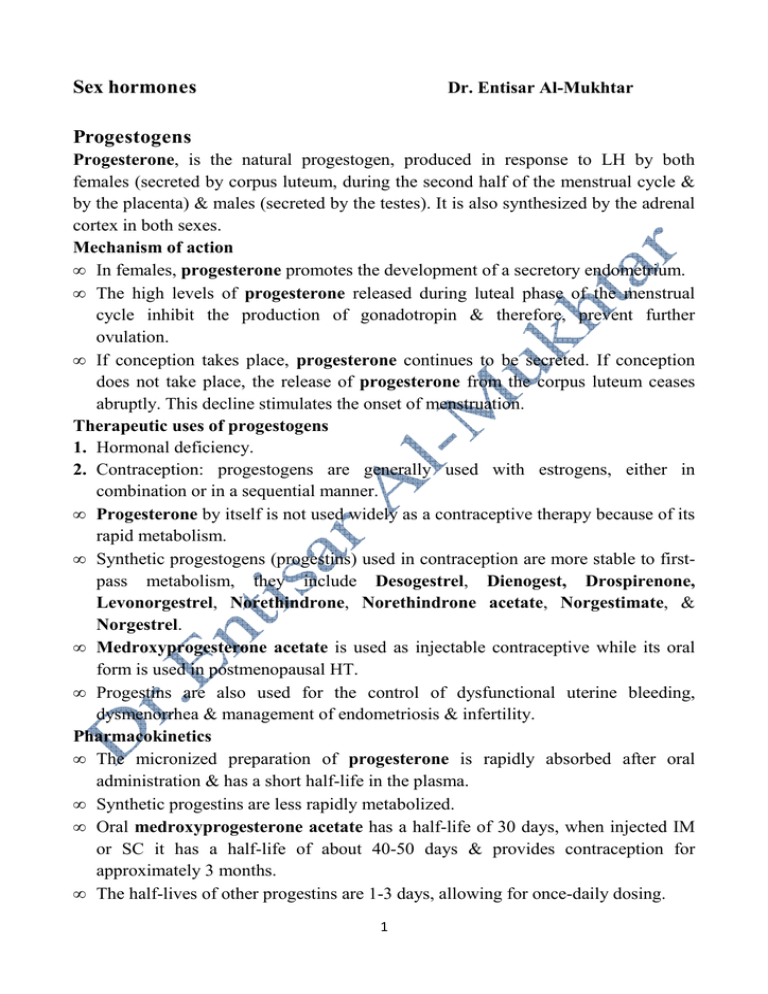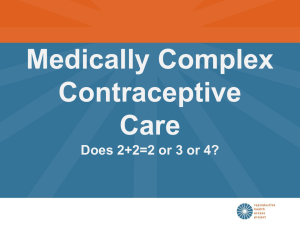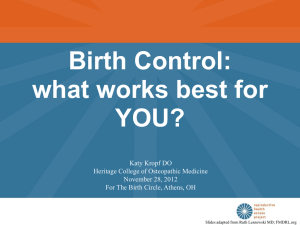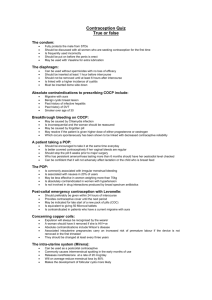Sex hormones Progestogens
advertisement

Sex hormones Dr. Entisar Al-Mukhtar Progestogens Progesterone, is the natural progestogen, produced in response to LH by both females (secreted by corpus luteum, during the second half of the menstrual cycle & by the placenta) & males (secreted by the testes). It is also synthesized by the adrenal cortex in both sexes. Mechanism of action • In females, progesterone promotes the development of a secretory endometrium. • The high levels of progesterone released during luteal phase of the menstrual cycle inhibit the production of gonadotropin & therefore, prevent further ovulation. • If conception takes place, progesterone continues to be secreted. If conception does not take place, the release of progesterone from the corpus luteum ceases abruptly. This decline stimulates the onset of menstruation. Therapeutic uses of progestogens 1. Hormonal deficiency. 2. Contraception: progestogens are generally used with estrogens, either in combination or in a sequential manner. • Progesterone by itself is not used widely as a contraceptive therapy because of its rapid metabolism. • Synthetic progestogens (progestins) used in contraception are more stable to firstpass metabolism, they include Desogestrel, Dienogest, Drospirenone, Levonorgestrel, Norethindrone, Norethindrone acetate, Norgestimate, & Norgestrel. • Medroxyprogesterone acetate is used as injectable contraceptive while its oral form is used in postmenopausal HT. • Progestins are also used for the control of dysfunctional uterine bleeding, dysmenorrhea & management of endometriosis & infertility. Pharmacokinetics • The micronized preparation of progesterone is rapidly absorbed after oral administration & has a short half-life in the plasma. • Synthetic progestins are less rapidly metabolized. • Oral medroxyprogesterone acetate has a half-life of 30 days, when injected IM or SC it has a half-life of about 40-50 days & provides contraception for approximately 3 months. • The half-lives of other progestins are 1-3 days, allowing for once-daily dosing. 1 Adverse effects • Headache, depression, weight gain & changes in libido. • The 19-nortestosterone derivatives (e.g, norethindrone, norethindrone acetate, norgestrel, levonorgestrel), possess some androgenic activity & can cause acne & hirsutism. Less androgenic progestins, such as norgestimate & drospirenone, may be preferred in women e.g., with acne. • Drospirenone has antimineralocorticoid effects, and its concurrent use with other drugs that increase serum potassium (e.g., ACEIs) may increase the risk of hyperkalemia. Antiprogestin Mifepristone • A progesterone antagonist with partial agonist activity (note: mifepristone also has potent antiglucocorticoid activity), its administration in early pregnancy usually results in abortion due to interference with the progesterone needed to maintain pregnancy. • Mifepristone is often combined with the PGE1 analog misoprostol (orally or I.V) to induce uterine contractions. • The major adverse effects are uterine bleeding & possibly an incomplete abortion. • Mifepristone has also been investigated as an oral & an emergency contraceptive. Contraceptives Interference with ovulation is the most common pharmacologic intervention for prevention of pregnancy. Major classes of contraceptives 1. Combination oral contraceptives (COCPs): • Containing a combination of an estrogen & a progestin are the most common type of oral contraceptive (OC). • Monophasic combination pills contain a constant dose of estrogen & progestin. • Triphasic OC mimic the natural female cycle & most contain a constant dose of estrogen with increasing doses of progestin given over three successive 7-day periods. • A combination of estradiol valerate & dienogest is available as a four-phasic OC. • With most OCs, active pills are taken for 21-24 days, followed by 4 to 7 days of placebo, for a total regimen of 28 days. • Withdrawal bleeding occurs during the hormone-free (placebo) interval. 2 Note: Most common estrogen in the combination pills is ethinyl estradiol & the most common progestins are norethindrone, norethindrone acetate, levonorgestrel, desogestrel, norgestimate & drospirenone. • COCPs are highly effective in achieving contraception. • An extended-cycle contraception (84 active pills followed by 7 days of placebo) results in less frequent withdrawal bleeding. • A continuous OC product (active pills taken every day) is also available. 2. Transdermal patch contraceptive: • An alternative to COCPs. • Containing ethinyl estradiol & the progestin norelgestromin. • One contraceptive patch is applied each week for 3 weeks to the abdomen, upper torso, or buttock. Week 4 is patch free & withdrawal bleeding occurs. • Its efficacy is comparable to that of the OC, but it is less effective in women weighing greater than 90 kg. • Contraindications & adverse effects are similar to those of OC. • Total estrogen exposure with the transdermal patch is greater than that seen with OC, which may increase the risk of adverse events such as thromboembolism. 3. Vaginal ring: • Containing ethinyl estradiol & etonogestrel. • The ring is inserted into the vagina & is left for 3 weeks, week 4 is ring free & withdrawal bleeding occurs. • Its efficacy, contraindications & adverse effects are similar to those of COCPs. 4. Progestin-only pills (mini-pill): • Usually containing, norethindrone, & are taken daily on a continuous schedule. • Progestin-only pills deliver a low, continuous dosage of drug. • Comparing to COCPs, mini-pill are less effective & may produce irregular menstrual cycles more frequently. • The progestin-only pill may be used for patients who are breastfeeding (unlike estrogen, progestins do not have an effect on milk production), intolerant to estrogen, smokers, or have other contraindications to estrogen. 5. Injectable progestin: • Medroxyprogesterone acetate is available in both IM & SC formulations injected every 3 months. 3 • Weight gain is a common adverse effect of medroxyprogesterone acetate. • Many women experience amenorrhea with medroxyprogesterone acetate. In addition, return to fertility may be delayed for several months after discontinuation. • It should not be continued for more than 2 years (unless the patient is unable to tolerate other contraceptive options) because patients may predispose to osteoporosis and/or fractures. 6. Progestin implants: • A subdermal implant containing etonogestrel provides long-term contraception (about 3 years). One 4-cm capsule is placed subdermally in the upper arm. • Implant is nearly as reliable as sterilization, & the effect is reversible after surgical remove. • Side effects include irregular menstrual bleeding & headaches. 7. Progestin intrauterine device: • A Levonorgestrel-releasing intrauterine system, it is a highly effective contraceptive. • Suitable for women who desire long-term contraception (3 - 5 years) and those having contraindications to estrogen. • Should be avoided in patients with pelvic inflammatory disease or a history of ectopic pregnancy. 8. Postcoital (emergency) contraception: • The overall risk of pregnancy is 15%, 30%, 12%, and near zero if an episode of coitus without effective contraception (unprotected intercourse) occurs 3 days before ovulation, 1 or 2 days before ovulation, day of ovulation and 1 or 2 days after ovulation respectively. • Postcoital contraception reduces the chance of pregnancy to between 0.2 & 3 %. • High doses of progestin (eg. 0.75 mg of levonorgestrel) or high doses of estrogen (100 µg of ethinyl estradiol) plus progestin (0.5 mg of levonorgestrel) are administered as soon as possible preferably within 72 hours of unprotected intercourse (the “morning-after pill”). A second dose should be taken 12 hours after the first dose. • A newer progestin-only regimen consists of a one-time dose of 1.5 mg levonorgestrel. 4 • The progestin-only emergency contraceptive regimens are generally better tolerated than the estrogen-progestin combination regimens. • An alternative emergency contraceptive is the progesterone agonist/antagonist ulipristal, it is indicated within 5 days of unprotected intercourse. • A single dose of mifepristone has also been used for emergency contraception. Mechanism of action Estrogen provides a negative feedback on the LH & FSH release, thus preventing ovulation. Progestin also inhibits LH release & thickens the cervical mucus, thus hampering the transport of sperm. Withdrawal of the progestin stimulates menstrual bleeding during the placebo week. Adverse effects: The incidence of adverse effects with OCs is determined by the specific compounds & combinations used. • Breast fullness, fluid retention, headache & nausea are most common with estrogens. Increased BP may also occur. • Progestins may cause depression, changes in libido, hirsutism, and acne. • Although rare, thromboembolism, thrombophlebitis, MI, and stroke may occur with use of OCs especially among smoker women over age 35. • The incidence of cervical cancer may be increased with OCs, because women are less likely to use additional barrier methods of contraception that reduce exposure to human papillomavirus (the primary risk factor for cervical cancer). [Note: OCs are associated with a decreased risk of cervical and ovarian cancer.] Contraindications: 1. OCs are contraindicated in the presence of cerebrovascular & thromboembolic disease, estrogen-dependent neoplasms, liver disease, and pregnancy. 2. COCPs should not be used in heavy smokers patients over the age of 35. Drug interactions: 1. Drugs like rifampin & bosentan induce metabolism of OCs reducing their efficacy (avoid concurrent use of such agents, or use an alternate barrier method of contraception). 2. Antibiotics that alter the normal GI flora may reduce enterohepatic recycling of the estrogen (in OCs), thus, an alternate method of contraception during is needed. 5





